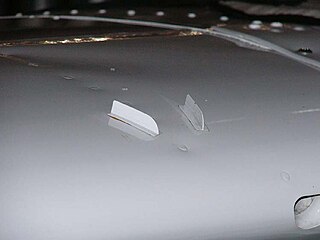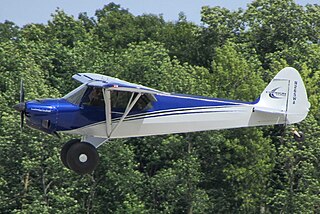
An aircraft is a vehicle that is able to fly by gaining support from the air. It counters the force of gravity by using either static lift or the dynamic lift of an airfoil, or, in a few cases, direct downward thrust from its engines. Common examples of aircraft include airplanes, helicopters, airships, gliders, paramotors, and hot air balloons.
Payload is the object or the entity which is being carried by an aircraft or launch vehicle. Sometimes payload also refers to the carrying capacity of an aircraft or launch vehicle, usually measured in terms of weight. Depending on the nature of the flight or mission, the payload of a vehicle may include cargo, passengers, flight crew, munitions, scientific instruments or experiments, or other equipment. Extra fuel, when optionally carried, is also considered part of the payload.

A vortex generator (VG) is an aerodynamic device, consisting of a small vane usually attached to a lifting surface or a rotor blade of a wind turbine. VGs may also be attached to some part of an aerodynamic vehicle such as an aircraft fuselage or a car. When the airfoil or the body is in motion relative to the air, the VG creates a vortex, which, by removing some part of the slow-moving boundary layer in contact with the airfoil surface, delays local flow separation and aerodynamic stalling, thereby improving the effectiveness of wings and control surfaces, such as flaps, elevators, ailerons, and rudders.

In aerodynamics, wing loading is the total mass of an aircraft or flying animal divided by the area of its wing. The stalling speed of an aircraft is partly determined by its wing loading.

The Bowers Fly Baby is a homebuilt, single-seat, open-cockpit, wood and fabric low-wing monoplane that was designed by famed United States aircraft designer and Boeing historian, Peter M. Bowers.

The maximum takeoff weight (MTOW) or maximum gross takeoff weight (MGTOW) or maximum takeoff mass (MTOM) of an aircraft is the maximum weight at which the pilot is allowed to attempt to take off, due to structural or other limits. The analogous term for rockets is gross lift-off mass, or GLOW. MTOW is usually specified in units of kilograms or pounds.

The IAI Westwind is a business jet initially produced by Aero Commander as the 1121 Jet Commander. Powered by twin GE CJ610 turbojets, it first flew on January 27, 1963, and received its type certification on November 4, 1964, before the first delivery. The program was bought by Israel Aircraft Industries (IAI) in 1968, which stretched it slightly into the 1123 Westwind, and then re-engined it with Garrett TFE731 turbofans into the 1124 Westwind. The 16,800–23,500 lb (7.6–10.7 t) MTOW aircraft can carry up to 8 or 10 passengers, and 442 were produced until 1987.

The PA-25 Pawnee is an agricultural aircraft produced by Piper Aircraft between 1959 and 1981. It remains a widely used aircraft in agricultural spraying and is also used as a tow plane, or tug, for launching gliders or for towing banners. In 1988, the design rights and support responsibility were sold to Latino Americana de Aviación of Argentina.

The Stroukoff YC-134, designed in 1956, was based heavily on the Fairchild C-123 Provider, itself designed by Michael Stroukoff. The United States military contracted with Stroukoff Aircraft Corporation to develop an improved version of the aircraft, combining features that the company had developed for the YC-123D and YC-123E.
Empty weight (EW) is the sum of the ‘as built’ manufacturer's empty weight (MEW), plus any standard items (SI) plus any operator items (OI), EW = MEW + SI + OI. The EW is calculated for each aircraft series and each unique configuration of an aircraft and is confirmed by periodically weighing it. The "Operating empty weight" (OEW) is the sum of the empty weight and the crew plus their baggage.

The 8GCBC Scout is a two-seat, high-wing, single-engined fixed conventional gear general aviation airplane that entered production in the United States in 1974. Designed for personal and commercial use, it is commonly found in utility roles such as bush flying—thanks to its short takeoff and landing (STOL) ability—as well as agriculture, pipeline patrol, and glider and banner towing.
The center of gravity (CG) of an aircraft is the point over which the aircraft would balance. Its position is calculated after supporting the aircraft on at least two sets of weighing scales or load cells and noting the weight shown on each set of scales or load cells. The center of gravity affects the stability of the aircraft. To ensure the aircraft is safe to fly, the center of gravity must fall within specified limits established by the aircraft manufacturer.
In aeronautics, the load factor is the ratio of the lift of an aircraft to its weight and represents a global measure of the stress ("load") to which the structure of the aircraft is subjected:

The Rockwell Commander 112 is an American four-seat single-engined general aviation aircraft designed and built by North American Rockwell starting in 1972. In 1976, they introduced the turbocharged version 112TC and mounting a larger engine with other minor improvements they introduced the Rockwell Commander 114. A total of approximately 1,300 examples of all models were produced before the production line shut down in 1980. In 1981, the type certificate owner was Gulfstream Aerospace, but that company had no interest in single-engine piston production.
The aircraft gross weight is the total aircraft weight at any moment during the flight or ground operation.
The maximum ramp weight (MRW) (also known as the maximum taxi weight (MTW)) is the maximum weight authorised for manoeuvring (taxiing or towing) an aircraft on the ground as limited by aircraft strength and airworthiness requirements. It includes the weight of taxi and run-up fuel for the engines and the auxiliary power unit (APU).

The aircraft design process is a loosely defined method used to balance many competing and demanding requirements to produce an aircraft that is strong, lightweight, economical and can carry an adequate payload while being sufficiently reliable to safely fly for the design life of the aircraft. Similar to, but more exacting than, the usual engineering design process, the technique is highly iterative, involving high-level configuration tradeoffs, a mixture of analysis and testing and the detailed examination of the adequacy of every part of the structure. For some types of aircraft, the design process is regulated by civil airworthiness authorities.

The CubCrafters CC11-160 Carbon Cub SS is an ASTM certified light-sport aircraft based on the Piper J-3 Cub manufactured by Cub Crafters. It is modernized, with light-weight carbon fiber components and a 180 hp (130 kW) engine.

An aircraft flight manual (AFM) is a paper book or electronic information set containing information required to operate an aircraft of certain type or particular aircraft of that type. The information within an AFM is also referred to a Technical Airworthiness Data (TAWD). A typical flight manual will contain the following: operating limitations, Normal/Abnormal/Emergency operating procedures, performance data and loading information.

The 1972 Puerto Rico DC-7 crash was an aviation accident that occurred on December 31, 1972, in Carolina, Puerto Rico. As a result of inadequate maintenance, the aircraft's No. 2 engine failed after takeoff. After initiating a turn to return to the airport, the aircraft eventually descended into, or attempted to ditch into, the ocean a mile offshore. All five people on board died, including baseball legend Roberto Clemente. The crash site was listed on the US National Register of Historic Places in 2022.

















